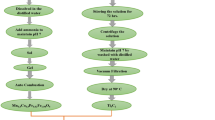Abstract
MXene belongs to the family of 2D carbides and nitrides. The controlling of process parameters is key to obtain high-quality MXene films. The layered structure of MXene is obtained successfully by tuning the process parameters which is confirmed through the presence of XRD peak (110) at 2 theta value of 60 degrees. Moreover, the accordion-like structure of MXene is confirmed through SEM which is also highly dependent on the process parameters. It is also observed that if the etchant with sufficient concentration is used for an optimised time the (002) peak gets shifted to a lower angle and confirms the increase in spacing of MXene layers to 12.92 Å. Further reduction in the etching time leads to a decrease in the d-spacing of MXene layers due to the presence of aluminium and the presence of defects corresponding to the unsuccessful removal of AlF3 by-products which is confirmed by (106), (108) and (109) XRD peaks. However, the occurrence of (106), (108) and (109) peaks which correspond to the growth of AlF3 is highly dependent on any variation in process parameters. The increase in the quantity also impacts the properties of MXene formed. It can be seen that increasing the quantity of hydrofluoric acid will lead to thicken the MXene layers. If etching is done for the greater quantity of HF, the toxicity is increased which leads to the greater number of fluorine groups which will lead to an increase in the number of defects in the MXene material. This paper also discusses the correlation of process parameters with that of the electrical properties of MXene layers. It is found that to get the best MXene layers in terms of structurally and electrically, the process parameters need to tune in such a way that the etching of aluminium can be done completely without increasing the fluorine content in the MXene. Herein, we report for the first time the fabrication of best optimised MXene film on the flexible polypropylene (PP) substrate using the best optimised parameters for supercapacitor applications and compared with the Polyethylene terephthalate (PET) and glass substrate results. The PP-supported MXene device exhibits lower contact resistance of 141 ohms and the areal capacitance of 82.6mF/cm2 at 5 mV/s and capacitive retention of 73.3%. The study opens up new possible designs for the high-performance devices employing different flake sizes, morphologies of MXene and their combinations.











Similar content being viewed by others
References:
R. Ruoff, Nat. Nanotechnol. 3, 10 (2008)
R. Mas-Balleste, C. Gomez-Navarro, J. Gomez-Herrero, F. Zamora, Nanoscale 3, 20 (2011)
M. Kurtoglu, M. Naguib, Y. Gogotsi, M.W. Barsoum, MRS Commun. 2, 133 (2012)
M. Malaki, A. Maleki, R.S. Varma, J. Mater. Chem. A 7, 10843 (2019)
J.L. Hart, K. Hantanasirisakul, A.C. Lang, B. Anasori, D. Pinto, Y. Pivak, J.T. van Omme, S.J. May, Y. Gogotsi, M.L. Taheri, Nat. Commun. 10, 1 (2019)
M. Naguib, B. Dyatkin, V. Presser, M.W. Barsoum, P. Simon, Y. Gogotsi, J. Come, P.-L. Taberna, Electrochem. Commun. 16, 61 (2012)
M. Yoshida, Y. Hoshiyama, J. Ommyoji, A. Yamaguchi, J. Ceram. Soc. Japan 118, 37 (2010)
M. Yan, L. Yang, C. Li, Y. Zou, J. Wuhan Univ. Technol. Sci. Ed. 34, 299 (2019)
M. Naguib, Nanomaterials Handbook (CRC Press, Boca Raton, 2017)
A. Byeon, A.B.A. Glushenkov, Elsevier 326, 686 (2016)
G. Ying, S. Kota, A.D. Dillon, A.T. Fafarman, M.W. Barsoum, FlatChem 8, 25 (2018)
M. Naguib, V.N. Mochalin, M.W. Barsoum, Y. Gogotsi, Adv. Mater. 26, 992 (2014)
M. Alhabeb, K. Maleski, B. Anasori, P. Lelyukh, L. Clark, S. Sin, Y. Gogotsi, Chem. Mater. 29, 7633 (2017)
M. Magnuson, J. Halim, L.-Å. Näslund, J. Electron Spectrosc. Relat. Phenom. 224, 27 (2018)
Z. Li, L. Wang, D. Sun, Y. Zhang, B. Liu, Q. Hu, A. Zhou, Mater. Sci. Eng. B 191, 33 (2015)
V.M.H. Ng, H. Huang, K. Zhou, P.S. Lee, W. Que, J.Z. Xu, L.B. Kong, J. Mater. Chem. A 5, 3039 (2017)
W. Chen, Z. Fan, L. Gu, X. Bao, C. Wang, Chem. Commun. 46, 3905 (2010)
Y. Zhang, H. Li, L. Pan, T. Lu, Z. Sun, J. Electroanal. Chem. 634, 68 (2009)
W.-C. Chen, T.-C. Wen, J. Power Sour. 117, 273 (2003)
M.E. Roberts, D.R. Wheeler, B.B. McKenzie, B.C. Bunker, J. Mater. Chem. 19, 6977 (2009)
B. Muthulakshmi, D. Kalpana, S. Pitchumani, N.G. Renganathan, J. Power Sour. 158, 1533 (2006)
K.-C. Tsay, L. Zhang, J. Zhang, Electrochim. Acta 60, 428 (2012)
T. Zhai, X. Lu, Y. Ling, M. Yu, G. Wang, T. Liu, C. Liang, Y. Tong, Y. Li, Adv. Mater. 26, 5869 (2014)
V. Branzoi, F. Branzoi, L. Pilan, Surf. Interface Anal. 42, 1266 (2010)
Y. He, W. Chen, X. Li, Z. Zhang, J. Fu, C. Zhao, E. Xie, ACS Nano 7, 174 (2013)
M. Liang, M. Zhao, H. Wang, J. Shen, X. Song, J. Mater. Chem. A 6, 2482 (2018)
Acknowledgements
This work is supported by the UGC NET-JRF, the University Grant Commission for the funds, SAI LABS Patiala, and Dr. Sushil Mittal, the Senior Professor at the department of physics in Thapar Institute of Engineering and Technology, Patiala for their support.
Author information
Authors and Affiliations
Corresponding author
Additional information
Publisher's Note
Springer Nature remains neutral with regard to jurisdictional claims in published maps and institutional affiliations.
Rights and permissions
About this article
Cite this article
Garg, R., Agarwal, A. & Agarwal, M. Synthesis and optimisation of MXene for supercapacitor application. J Mater Sci: Mater Electron 31, 18614–18626 (2020). https://doi.org/10.1007/s10854-020-04404-5
Received:
Accepted:
Published:
Issue Date:
DOI: https://doi.org/10.1007/s10854-020-04404-5




